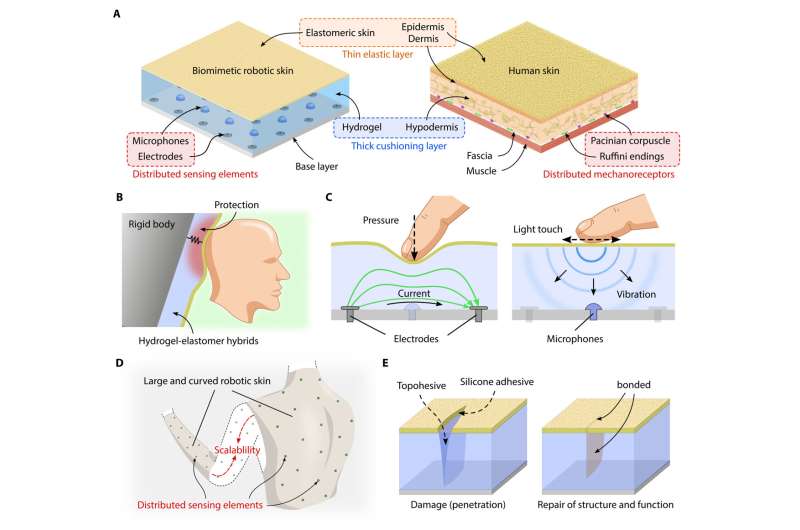Bioinspired electronic skin. Credit: Science Robotics (2022). DOI: 10.1126/scirobotics.abm7187
A team of researchers at Korea Advanced Institute of Science and Technology, working with one colleague from MIT and another from the University of Stuttgart, has developed a biomimetic elastomeric robot skin that has tactile sensing abilities. Their work has been published in the journal Science Robotics.
Roboticists continue to work on improving robot abilities and to make them more human-like. In this new effort, the researchers gave a robot arm the ability to detect such sensations as a pat, tickling, wind, or something stroking its surface. They accomplished this by partially imitating human skin.
The new robot skin is multi-layered, like human skin, to allow for different functions. The top layer is made of a rubber-like polymer resembling human skin. Beneath that, the researchers added a hydrogel to imitate the human epidermis. They chose a hydrogel because it not only deforms when pressed, but jiggles when bumped. By embedding sensors to detect these reactions, the skin is able to sense things like a finger press by monitoring the pressure of the hydrogel and the direction of its movement. If something taps against it, the system senses and measures ripples in the hydrogel to gauge what the tap felt like.
Likewise, the system senses tickling by noting the size and types of multiple ripples that are generated. To make sense of the data coming from the sensors embedded in the hydrogel, the researchers added an AI application trained to associate dynamics in the hydrogel with the activities that cause them. The researchers also built the skin so that if it is ripped or torn, it can be repaired using a silicon adhesive.
Explainer video for bioinspired electronic skin. Credit: Science Robotics (2022). DOI: 10.1126/scirobotics.abm7187
The team suggests that their robot arm could be used as a limb for either a robot or a human being, though for the latter, a sensory feedback method would be required, such as connecting wires in the arm to nerves in the shoulder of the person wearing the prosthetic.
More information: K. Park et al, A biomimetic elastomeric robot skin using electrical impedance and acoustic tomography for tactile sensing, Science Robotics (2022). DOI: 10.1126/scirobotics.abm7187
Journal information: Science Robotics
© 2022 Science X Network
























